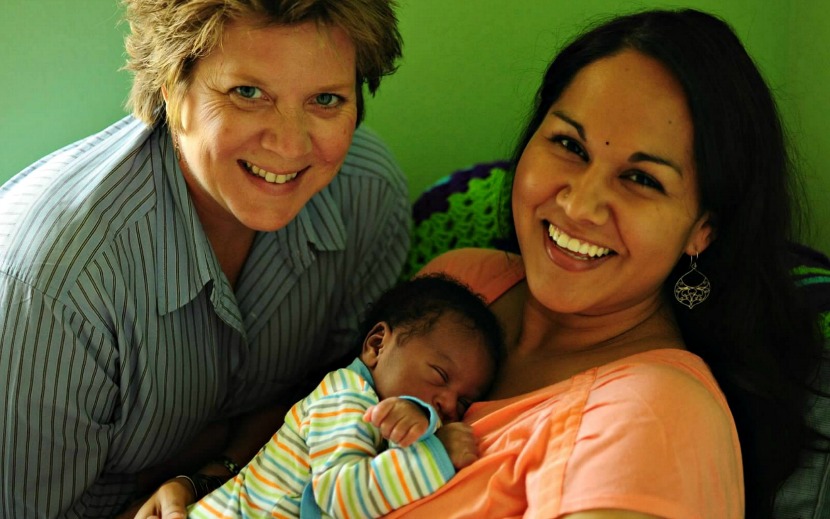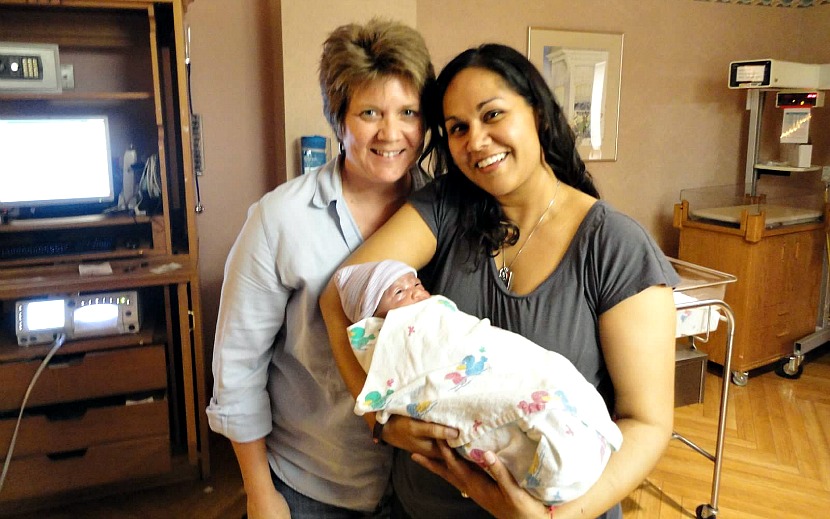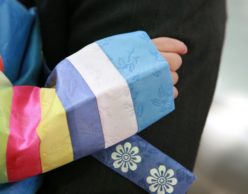No Box Unchecked: How We Became A Family

Indian. White. Black. Gay. Interracial. Biracial. Multiracial. Biological. Adopted. Mash-Up families are complex. Adoptive ones especially so. In this, the first of a three-part series, our Indian-American Mash-Up Nishta Mehra tells us how Shiv, her Black son, came into her and her white partner’s life. Because sometimes we choose our families, and sometimes they choose us.
I am one of those people who always knew that I wanted to have kids. I anticipated getting pregnant, giving birth, and experiencing the biological phenomenon of motherhood. Even coming out did not disrupt this narrative, except to push me to call my dear friend Wayne, one of the best men I know, and ask him if he would consider being my someday sperm donor. It was sort of an insane phone call — we were, like, 21 — but I figured I needed to ask the question before he met the woman he wanted to spend the rest of his life with, so that my request would pre-date her and be grandfathered in. Wayne asked if he could think about it, then called me back a few weeks later and said yes.
In case you’re wondering, Wayne is, like all the people I’ve ever dated, white. I’m not an Indian girl who grew up thinking it was important for me to marry an Indian dude; even my parents assumed I would end up with a white guy, and they didn’t object. I guess it was a simple matter of probability — most of the people I was surrounded by were white — but none of us had an issue with the idea that my future family could be mixed race. My parents and I all had, and have, meaningful relationships with all kinds of non-Indian folks. Everyone was good with the idea of cute little half-white, half-brown babies.
As long as there were babies — THERE HAD TO BE BABIES.

Then I fell in love with Jill. Nineteen years my elder, she had long before decided not to have kids. Despite my desire for kids, neither of us could imagine walking away from the relationship. Since I was still really young and in no rush, we let the issue lie fallow for a while. Then Bruno happened.
One morning, Jill read a story in our local paper about the millions of children in Africa who had lost their entire families to AIDS. Along with the story was a picture of Bruno, a young boy whose family had been ravaged by the disease. He had no one. Jill fell in love.
For several days, without telling anyone, even me, Jill worked to track down the photographer who had taken the picture, in order to find Bruno. She was fully prepared to fly to Uganda and adopt him.
In the end, though she was unable to find him, her perspective on parenting was irreparably changed. “Let’s adopt,” she urged me. “We can’t be Bruno’s parents, but we can provide a good home for a child who needs one.”
Giving up my attachment to biological parenting was not as difficult as I thought. The idea of giving birth was still plenty compelling, but it just couldn’t compete with Jill’s enthusiastic vision of adoption. I thought about my extended network of chosen family, the people who taught me that biology is not necessary for love. I called Wayne and told him he was off the hook.
The world of adoption is a strange, subterranean otherworld.
The world of adoption is a strange, subterranean otherworld. Before you enter it, you may be conscious that it exists, but once you’re in it, you realize that you had no idea what it was really like. The waters are uncharted but navigable (guides are available for hire, and some are much, much better than others), and the air is murky but undeniably beautiful.
Adoption forces you to give up your sense of control and to be continually reminded that control is an illusion anyway. I mean, my pregnant friends refused to even look in the direction of a deli meat sandwich (Listeria! Danger!), but Jill and I were overjoyed to be matched with a birth mother who was “only” smoking a few cigarettes a day. At least there was no alcohol! No illegal drugs!
Some days it was easier to trust the process than others. Some days I wanted to block every person posting sonogram pictures on Facebook. Some days I cheated, and, even though I’d been advised to hold off on decorating the nursery or registering for baby things, I bought green paint at Home Depot and copies of Charlotte’s Web and Where the Wild Things Are. Some days I would open the fridge and see the bottle of Veuve Clicquot that friends gifted us, “for when the baby comes,” and despair of ever being able to open it.
Every day was more breathtaking, scary, and sacred than I ever could have imagined.
One of the questions they ask you is: What kind of baby do you want?
Back when our baby planning was still theoretical and “someday,” Jill and I toyed with the idea of adopting from India, but it only took a half-hour’s worth of internet reading to quash that thought. India isn’t particularly LGBT-friendly, and they don’t adopt babies out to single women unless they are over 30. Maybe we could have pulled some strings, but it likely would have cost more money and time than necessary. Then we thought maybe some teenage Indian girl would get knocked up and one of my aunties would hear about it through the grapevine and we could get ourselves a baby that way…but that never panned out.
Instead, I got hit with a pretty serious wave of MUST. HAVE. BABY. NOW. We started to research domestic adoption agencies in earnest.
Going through the adoption process is pretty excellent preparation for parenting. A social worker asks you to complete something called an “Autobiographical Instrument,” a document consisting of a couple hundred (no exaggeration) questions about everything from your plans regarding discipline and daycare to how you handle stress in your marriage. Your significant other will fill one of these out, too. The aforementioned social worker will also complete a Home Study, which consists of a multi-hour, in-person interview and inspection of your house. There will be additional paperwork. Lots and lots of paperwork: letters of recommendation, bank statements, paycheck stubs, detailed household budgets, floor plans, FBI background checks, personal statements.
You will, at times, feel frustrated to have to be vetted in this way when plenty of seemingly less qualified people manage to go out and have themselves some babies without answering any damn questions.
One of the questions they ask you is: What kind of baby do you want?
They put it more delicately than that, of course, but that is essentially what they are asking. The form contains a list with checkboxes — boy, girl, twins, Caucasian, Hispanic, Asian, African-American, American Indian — and you check the ones you are okay with. There are checkboxes for alcohol and drug exposure, too, and family history of mental illness. Things get pretty intense pretty quickly.
I prepared myself to be mistaken for the nanny.
I admit I hesitated at the thought of raising a Black child — specifically, a Black son. I worried that we weren’t the right people to do that work, that it somehow wasn’t right, that we wouldn’t know how, that our kid would wake up someday and look around and say, “What the heck am I doing with you people?” But when it came to actually filling out the forms and checking the boxes for gender and ethnicity, I couldn’t bring myself to leave any of them unchecked. With Jill looking over my shoulder, I checked every damn one.
Still, we were told that it was extremely unlikely that we would, as a pair of women, be matched with a Black birth mother. I assumed throughout the whole process that our child would look more like Jill than like me. I prepared myself to be mistaken for the nanny.
Then we got the email. Shiv’s birth mother, who is Black, was seven months pregnant and had chosen us to be her child’s parents.
Shiv’s adoption was partially open, which means that we met and spent time with his birth mother, Mama D, before he was born. It means that she chose us to be his parents, an affirmation and a charge so powerful that, when I struggle to get out of bed in the morning, it pulls me out by the collar. Partially open also means that we can tell Shiv things like the fact that he apparently gave his Mama D wicked cravings for barbacoa tacos nearly every day of her third trimester. We can show him her picture. We can honor her in our speaking.
We are no longer in contact with Mama D, but I think about her every day. I think about what a crazy thing it is to owe so much of my happiness to someone I’ll likely never see again, someone who met me for the first time just 17 days before she let me stand inside her hospital room and watch her give birth. I think about how she sat holding Shiv, all swaddled in his standard-issue footprint blanket, and looked down and told him, “You have two wonderful parents and they are going to raise you to be a gentleman.”
I no longer worry that Shiv will wake up someday and say “What am I doing with you people?” At least, I don’t think he’ll do that any more than any other kid does. He is our son, and I have felt from the moment I held him that he is ours.
In some ways, we don’t even think about being a tri-color family; neither Jill nor I are essentialist about race, nor do we wish to raise Shiv to be. But we also aren’t head-in-the-sand “La la la, colorblind society!’ types, either. We are constantly working on that balance — a balance that has, in the last two-and-a-half years, been interspersed with sheer terror as we’ve been forced to reckon with what it means to be the parents of a Black boy in America right now.
Read Part 2 of Nishta’s story: Building a Village, One Papaw at a Time.





